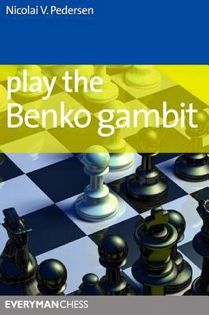Play The Benko Gambit
Nicolai Pedersen

36 years ago Toronto. Grandmaster Walter Browne had made a name for himself by making the Benko Gambit part of his repertoire. In fact, at one point he began to refer to the opening as the Browne-Benko Gambit. He was paired against a 1650 player, and everyone understood that his opponent was going to be eviscerated. Walter was White, and the game began 1.d4 Nf6 2.c4 c5 3.d5 b5! Really? This random amateur dared to play the Benko Gambit against one of the worlds foremost authorities on this line? Incredibly, Black outplayed his prestigious opponent in the opening and Walter had to struggle to make a draw! Afterwards, embarrassed by the result, Browne shouted: He’s 200 points stronger than this rating, thats why! Perhaps not the best thing to say, since that would have made his opponent 1850 vs. a grandmaster.
The point of this story was not to humiliate Mr. Browne (who had Fischer on the ropes when they played!) every chess professional runs into a low rated chainsaw at some time(s) in his career. The point was to drive home a great truth: The Benko Gambit is one hell of an annoying opening! Theres a lot of theory, but even a 1400 with a poor memory can learn the basic ideas and play most of the lines in a logical fashion the Benko is an opening thats idea/plan driven, and though the sharpest modern lines now demand a good deal of memorization, knowing the Benko Gambits soul can take you a long, long way.
There have been quite a few books written about this opening over the years, but it was time for an update, and Pedersens PLAY THE BENKO GAMBIT fills this need. Unlike a complete treatise on the Benko (which could easily fill more than a thousand pages), PLAY THE BENKO GAMBIT gives us a Black repertoire. This means that he will recommend what he feels are the best lines (you wont have to figure this out for yourself) for Black, and will also discuss the typical plans and ideas. Moreover he also gives recommendations for the inevitable occasions when your opponent says to himself, Oh, hes going to play that blasted Benko Gambit! Ill avoid it by , which is a very welcome addition to the book.
The book begins (after the Table of Contents) with a bibliography, which tells us that the author went over all the key books and DVDs on the Benko (why reinvent the wheel?), and he also makes copious use of MegaBase 2011. The Introduction follows, and its filled with several pages of typical plans and ideas.
The main breakdown of the book gives us three parts: BENKO ACCEPTED (The Fianchetto Variation, The Classical Variation, and 5.e3), BENKO DECLINED (The 5.f3 Variation, White plays b5-b6, Other options for White), ANTI-BENKO (The Kasparov Gambit, the Topalov Variation). The books ends with a very welcome Index of Variations, which I feel is a must for any serious opening book, and an Index of Complete Games.
Mr. Pedersen mixes instructive prose together with variations quite well, and he also mixes all the latest theoretical nuances with some original analysis of his own. His philosophy is quite clear: Find sound lines that have held up to upper tier battles, but make sure that as many variations as possible are sharp and give Black serious chances of outplaying his opponent.
To me, his Anti-Benko choices are extremely interesting, and really reach for as much hyper-aggression as possible. For example, 1.d4 Nf6 2.c4 c5 3.Nf3 is something a Benko Gambit player will see quite often. White wants to keep the position quiet and not allow Black his Benko dynamics. However, by 3 …cxd4 4.Nxd4 e5 5.Nb5 d5 6.cxd5 Bc5! (of course, 6 …Nxd5?? 7.Qxd5 wins for White) Black sacrifices a pawn for all sorts of attacking chances. In fact, though this might be a bit more speculative than the Benko Gambit (Pedersen insists it completely sound), its far more terrifying (perfect against an opponent who wanted peace and quiet)!
Another way players with the White piece can avoid the Benko is 1.d4 Nf6 2.Nf3 c5 3.d5 and now Pedersen recommends 3 …b5 4.Bg5 Ne4 (a favorite of Topalov). Once again, Black is the aggressor while White is trying to stem the tide, and once again its clear that White has failed to create a quiet environment for himself.
If you play the Benko Gambit, or if you are thinking about adding it to your repertoire, this book is a must buy.
